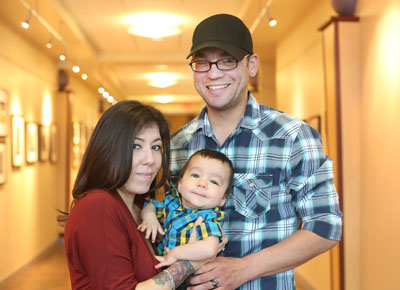John and Valerie Longoria breathed a sigh of relief when the team lead by John C. Pope IV, M.D., professor of Urologic Surgery and Pediatrics, told them a minor procedure on their 8-month-old son Maverick had been successful, and they could soon take their son home to Oak Grove, Kentucky. But then, things quickly changed.

“The surgery was finished,” said Sheila Sitarich, a certified registered nurse anesthetist (CRNA) who was monitoring Maverick’s vital signs in the operating room at Monroe Carell Jr. Children’s Hospital at Vanderbilt. “They were applying the dressing when I noticed the end tidal CO2 [the carbon dioxide his body was producing] had gone up. I took him off the ventilator and started hand ventilating him, thinking it was just inadequate respirations. The CO2 started going up higher. He was hot, and his heart rate was 200, so we knew we had a problem.”
Sitarich suspected a rare reaction to anesthetic gas called malignant hyperthermia (MH). MH is the result of a genetic disorder and is associated with the administration of inhaled anesthetics and the drug succinylcholine, a muscle relaxant that eases breathing tube insertion. Because of this, the reaction typically occurs in operating rooms and emergency rooms.
The Malignant Hyperthermia Association of the United States estimates that MH complicates one in about 100,000 surgeries in adults and one in about 30,000 surgical procedures in children. The drug dantrolene can reverse an MH reaction, but only if it is administered quickly.
Malignant hyperthermia is very rare. At Vanderbilt University Medical Center (VUMC), which performs more than 67,000 surgeries each year, only one or two cases are seen annually.
“You really have just minutes to respond,” said Elisabeth Hughes, M.D., assistant professor of Anesthesiology. “The muscle breakdown can be fast enough to release enough potassium that you can actually have cardiac arrhythmias and ischemia in the operating room.”
Sitarich called in Hughes, CRNA Heather Frankenfield, and others to assist. Maverick was intubated, given oxygen, and switched to an intravenous anesthetic. Ice bags were packed around him, and a nasogastric tube was added to internally flush his body with chilled saline. Hughes asked Operating Room Pharmacy Supervisor Ralph DiPalma, D.Ph., to come observe the administration of a new dantrolene formulation that had never been used at the Children’s Hospital. The drug, Ryanodex, had been approved by the Food and Drug Administration in 2014 and, after a review process, was added to the VUMC pharmacy in 2016.
“It was evident how easy this drug was to administer in comparison to what it would’ve been like with the older one,” DiPalma said. “This was easy to reconstitute, and the volume we needed to give was so little.”
After a few Ryanodex doses, Maverick’s temperature went down, and his other symptoms eased. He was transferred to the intensive care unit for observation, and the next day, he was well enough to go home. Hughes said those critical minutes in the operating room seemed to run like clockwork; it turns out that many on the team had recently rehearsed just such an event. A simulation exercise on MH was held two weeks before Maverick’s surgery, and it involved all perioperative staff – from scrub techs to surgeons and anesthesiologists. A team worked a simulated MH case in the post-anesthesia care unit (PACU), while an audience watched the action via a video feed. Then, everyone participated in a debriefing.
“It was a coincidence that an MH case occurred shortly after we had completed the simulation exercise, and many of those working in the operating room that day had participated in the exercise,” said Arna Banerjee, M.D., assistant dean of Simulation in Medical Education. “This is a perfect example of why simulation is so important. Those medical professionals had their response reinforced by simulation training, and they proceeded through the case with confidence.”
During Maverick’s post-operative visit to Pope, the Longorias said they’ve been educating other family members about MH, and they’re planning on having tests to definitively learn who has the genetic mutation that leads to MH. They’ve told Maverick’s physicians about his diagnosis and are making sure it is added to his medical records.
“Maverick is doing great,” Valerie Longoria said. “He is crawling everywhere and getting into everything! He’s saying Momma and Daddy. We are just so grateful for this hospital and for everyone here at Vanderbilt. We really hope other people can learn from what happened with Maverick.”












